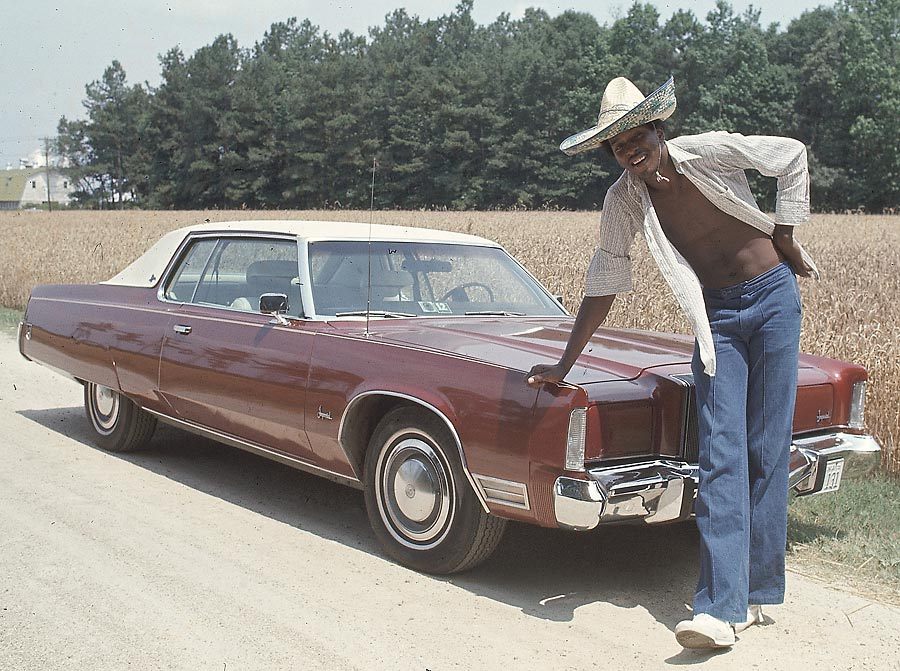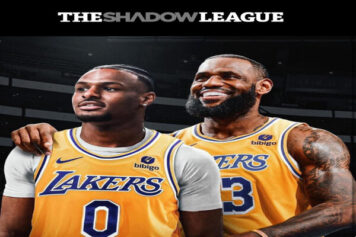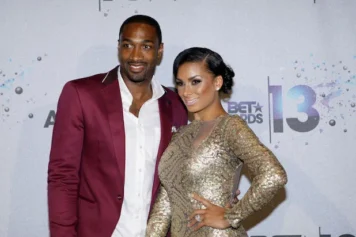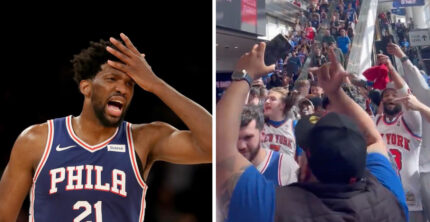Five years ago we lost one of the greatest basketball players to ever grace an NBA court. One of the last Mohicans — a dominating inside presence from a lost era, when elite centers were the focal point of any NBA offense.
Who was the first player in team sports history to earn $1 Million per year? Ummm, that would be Moses Malone. The first to earn $2 Million per? Again, the answer would be Moses. Who made it possible for LeBron, Kevin Garnett or Kobe Bryant to take the express train from the high school prom to the NBA Hall of Fame? Moses!
I find myself disappointed that his contributions to our beloved game, and his historical significance, like many of the games former titans, are mere footnotes for many young kids whose interest in hoops was sparked by guys like Allen Iverson, Tracy McGrady, Vince Carter, Kevin Durant, Shaq, Kobe or LeBron.
Dont get me wrong, I love those guys. But when I fell in love with basketball as a kid, due to the brilliance of guys like Magic Johnson, Bernard King, George The Iceman Gervin and Julius Erving, among others, I was also very curious about those who came before them.
I’d often walk long distances or catch a bus en route to a very exciting place, the local library, to ingest any book I could find on the history of the game. I don’t see that same hunger to be well-read, informed and knowledgeable today.
Maybe I’m just talking to the wrong teenagers and young adults. Or maybe I’m in the beginning stages of being that crotchety, curmudgeonly old dude who romanticizes over the past and unfairly discredits the current 25-and-under demographic.
Either way, when I walk into a high school gym and see a tenacious, relentless, ferocious rebounder with an unrelenting work ethic, I’m always tempted to advise him to study Moses work.
Because those are the words,”Tenacious! Relentless! Ferocious Rebounder! Unrelenting Work Ethic!” that immediately come to mind when I think of one of the games true pioneers.
He was the modern eras trailblazer, the first who went from ashy to classy, directly from high school to the pros, and blossomed into one of the greatest big men the game has ever seen.
The Journey of Moses Malone
Moses Eugene Malone grew up in poverty and was raised by his mother, Mary, in Petersburg, Virginia. Mary, a nurses aide, raised her son in a two-bedroom row house that was less than a block away from the Virginia Avenue playground.
By the time he was 12 years old, the young boy, who was admittedly shy and clumsy, already stood 6-foot-3. The game of football, with the religious fervor it engenders in certain parts of the southern American tapestry, held his interest early on.
But once he cradled a basketball in his hands, the single-mindedness and determination that proved a hallmark to his later success became evident.
When Mo first started playing on Virginia Avenue, he was still growing fast and he was very awkward, his close friend David Pair told Sports Illustrated’s John Schulian in 1974 during Malones senior year in high school. “They used to laugh at him and beat him all the time. Now when we have games there, we make Mo agree not to come inside. He has to shoot from outside, or we don’t let him play”
“I didn’t pick up a basketball until I was 13 and a half, but I worked hard even then, Moses said in a 1984 Playboy Magazine interview. Every day after school, I’d go over to the playground and play ball until about two in the morning. The only trouble I had was I kept wearing out my shoes. Back then, I didn’t get no high-priced shoes; I had to get them old P.F. Flyers. I’d wear them for about five days and then it was time for a new pair.”
The 6-foot-11 man-child led Petersburg High School to 50 straight victories and back-to-back state championships, initiating an avalanche of salivating recruiters that descended on the town.

Howard Garfinkel, the legendary scout and Five-Star All-Star Camp czar, once said, “Moses is the first kid that’s been bigger than the camp itself. He’s the best we ever had.”
At Five Star, players were ranked from one to five stars, with five being an elite player with remarkable potential. Moses earned a ranking of seven stars from Garfinkel.
One of my friends, role models, advisors and mentors, the visionary college basketball coaching legend, Mr. George Raveling, a Basketball Hall of Fame inductee, once said, during Malones senior year in high school, when he averaged a mind-boggling 36 points, 26 rebounds and 10 blocked shots a game, that …Moses will re-write the Ten Commandments of Basketball.
In the first-ever McDonald’s Capital Classic game in 1974, which matched a team of U.S. All-Stars against the best from the Washington, D.C. area, perimeter guard play was on prominent display as the New York City sensation, Butch Lee from Dewitt Clinton High School, earned Most Valuable Player honors with his electrifying 23 points. But Moses grabbed 17 rebounds and rejected many a weak shot into the stands while altering countless others.
Over 300 colleges offered the big man a scholarship. A lot of them came bearing gifts while dangling cars, cash, houses, girls and the moon. Oral Roberts himself, the fantastically wealthy Methodist-Pentecostal televangelist, showed up and went so far as to promise that he’d cure his mother of a bleeding ulcer if Moses attended Roberts eponymous university.
But Malone was innately and intelligently able to see through the slick recruiting circus almost immediately, digesting the business side of the game in ways that most couldn’t.
“Sometimes they brought me in to meet the President of the university, who talked to me like he wanted to be my father,” Moses once told Sports Illustrated’s Pat Putnam. “That made me laugh. They fixed me up with dates. Then when I got home, those girls called me long distance and pretended they were in love with me. What kind of stuff is that?”
Classic Stuff !!!
Malone always wore a serious expression on the court, during his recruitment and while interacting with the media. His shyness and penchant for saying only what was necessary with a deep baritone, in the speech pattern vernacular of his southern upbringing, fooled many who falsely assumed that he was dumb.
Some people mistake that shyness for stupidity, Virginia Commonwealth Coach Chuck Noe once said. “But he’s a lot smarter than some of the people who are recruiting him.”
While Maryland Head Coach Lefty Driesell won the recruiting war, the Utah Stars of the American Basketball Association drafted Moses in the third round of the 1974 ABA draft, a selection that very few took seriously. Many saw it as a shameless marketing ploy.
But the Utah franchise pursued Moses with vigor. Suffice it to say, Lefty was not enthralled when he learned that the Stars were offering his most prized recruit a $3 million contract.
But to his credit, Driesell understood what that life-altering sum meant, looked beyond his own National Championship ambitions, and advised Malone, who’d merely been enrolled in classes for a few days in College Park, to hire an attorney that would assist him with the negotiation process.
If the Utah Stars reps initially thought the deal was a slam dunk, they were soon corrected. They arrived in Maryland on a Thursday with no luggage, and a deal did not get done until a week later.
It was unreal, Bucky Buckwalter, the Stars coach once said. “We put 932 miles on the car in six days just going between Petersburg and Washington.”
Most thought Moses wasn’t ready and didn’t have the physical toughness required for pro ball. But a small yet significant detail that was largely unknown was that he’d already had some next-level exposure in the combat zone near the rim.
His high school team had actually played tons of exhibition games against inmates from the Virginia State Penitentiary in Richmond.
“You know they were rough,” Moses told Sports Illustrated’s great writer, Roy S. Johnson, in the early 1980s. “They had this guy called Milkman, who was bigger than I was and knew no fouls.”
When Johnson asked how Milkman acquired the nickname, Moses laughed and shook his head saying, “Because he killed one, MAN!”
During his first pro season, at a slim 215 pounds, his rebounding and defensive abilities shocked many seasoned basketball executives and journalists, men who’d been around the game for years.
“He’s so quick its unbelievable,” Buckwalter told Sports Illustrated’s Pat Putnam. “One minute he’s just loping down the court, maybe a little more than halfway, and then you blink and there he is coming down with a rebound. He just stuns me. Here he is, only an inch or so under seven feet, and he’s as quick as a guard. Hell, he’s quicker than a lot of guards”
That quickness was augmented by innate instincts, almost a telepathy, around the rim. And the question of him being able to take the pounding quickly lost its mystery.
There is the matter of toughness, Buckwalter continued. “They know he’s young and a lot of guys have really laid it on him, trying to intimidate him. Elbows, knees, grabbing, shoving, the whole bag. And he’s given it right back. That kid doesn’t back up an inch. I knew what was going to happen, so I told our guys to go after him right from the first day of practice. We had to find out. They used to kid him by calling him The Rookie. Then one day after a rough workout he walked into the locker room and told them, ‘You guys can keep on calling me a rookie, but Im the toughest damn rookie you ever saw!”

Immediate NBA Impact
As a 19-year-old rookie, he averaged 19 points and 15 rebounds per game.
After another year with the Spirits of St. Louis ABA franchise, the leagues merged and Moses wound up a Houston Rocket. In his first year in the NBA, he shattered Paul Silas offensive rebounds record (though the stat was not kept when Bill Russell and Wilt Chamberlain played) and led the Rockets to the Eastern Conference Finals (they were in the East back then).
By his fifth pro year, which would have been his rookie campaign had he stayed in college at Maryland, at the age of 23, he was the NBA’s Most Valuable Player while putting up 25 points and 18 rebounds a night. Keep in mind that the incredible Kareem Abdul Jabbar was considered, hands down, the leagues best center during the 1970s. But from the moment Moses entered the league, Kareems status was no longer a given.
Without going into his accomplishments, which would keep me here all day, understand that Malone dominated the paint on par with the best of the best.
In 1983, after being named MVP again the previous year, he took one of the greatest teams ever, the Philadelphia 76ers with Doctor J, Mo Cheeks, Andrew Toney a.k.a. The Boston Strangler, and Bobby Jones to the crescendo of the game.
The 1983 Sixers lost only one playoff contest as Moses averaged 26 points and 16 rebounds per game during the postseason. The previous year, without Moses, Philly lost to the Lakers in the Finals.

In 83, he dominated Kareem on the boards as Philly swept the series, almost making good on his infamous Fo, Fo, Fo prediction for the postseason. (For folks that dont speak fluent Moses, hed predicted that the Sixers would sweep, winning four games in a row against each opponent to win the title while going undefeated in the postseason)
He was a professional’s professional for 21 years, one of the best big men, leaders, defenders and rebounders, particularly on the offensive end, that the game has and will ever see.
And the fantastic part was that he so willingly shared of himself with his protg Hakeem Olajuwon, who would go on to coagulate into a vision basketball had never seen before.
For those who are unfamiliar with Hakeem’s back story, he was an incredibly raw prospect from the cosmopolitan city of Lagos, Nigeria when he arrived at the University of Houston in the early ’80s. During his redshirt freshman year in 1981-1982, he was a spark of raw energy off the bench, a dizzying compilation of arms and legs who rejected shots and delivered monstrous dunks with the same reckless abandon that he collected personal fouls.
In the Final Four that year against North Carolina, which featured Sam Perkins, James Worthy and a freshman named Michael Jordan, Olajuwon scored a mere two points and grabbed six rebounds in 20 minutes of action.
But that summer, Hakeem playing the role of Luke Skywalker, came under the tutelage of Yoda, played by Moses. And that knowledge transfer and mentorship would shake the global foundations of basketball.
At Houstons Fonde Recreation Center during the off-season, Olajuwon would go on to earn his hoops Ph D.
Moses didn’t come to the game until his teens as well, but his hard work and determination on the playgrounds of Petersburg, Virginia laid the foundation of his future legend.
The vet from the American South found a kindred spirit and willing disciple in the Nigerian import. Hakeem’s development over that one summer was so Bunyanesque, it was truly unfathomable.
The rugged battles with Moses, the reigning NBA MVP at the time, forced Olajuwon to dig deep. Those lessons, administered at the highest levels of banging, shoving and pushing, allowed Hakeem to distend his skill set.

Understanding that he couldn’t move an immovable force, The Dream had to learn how to succeed, as the great martial artist Bruce Lee once said, at the art of fighting without fighting.
He incorporated the old soccer and handball moves that he grew up practicing in Nigeria, utilizing the change of pace, stutter steps, head fakes and shake-n-bake moves that would later annihilate his future competitors.
Moses gave me nothing easy on the floor, Hakeem once told the Houston Chronicle’s Fran Blineberry. He made me earn everything, and it made me expand the limits of my game.
The guy worked hard every second, Olajuwon’s college teammate Michael Young said in Filip Bondy’s book, Tip Off, How The 1984 NBA Draft Changed Basketball Forever. He already had great footwork from playing soccer. Then he played a lot of pick up. He was a gym rat.
On one occasion at the Fonde Recreation Center, at the end of the summer, Malone called a foul. And Olajuwon exploded.
Awww no! Dammit Mo, Be a Mon! he screamed.
Anyone else would not have lived to tell that story. But Moses, who had taken a liking to the 20-year-old Hakeem, was proudly amused.
“And then, boom, it seemed to happen overnight,” Young says in Tip Off. His game just developed.
Against Moses, Hakeem was freer, looser, more assertive, going to his killer move on instinct, former NBA player McCoy McLemore told Sports Illustrated’s Curry Kirkpatrick. It was like he was no longer a foreigner but a cocky, hip, black schoolyard dude. Confident. A hustler. He also worked the weights and got his weight up to 255. Moses couldn’t take a day off against him anymore. They were two titans. The beauty of it was both were laughing Moses was so proud and tickled. They recognized they could stop each other while nobody else could. It was a dead-standoff.
Most folks are unaware of how important Moses’ mentorship was, how his teaching ultimately led to Hakeem’s transformation into the dominating force who simply became known by his new nickname, “The Dream.”
Hakeem passed down Moses’ legacy of mentorship, as he helped tutor the likes of Dwight Howard, Yao Ming, Amar’e Stoudemire, Carmelo, Kobe and LeBron, among others, over the years.

He wasn’t the fastest and didn’t jump the highest. And, by starting center standards, he wasn’t very tall. He simply showed up every day with his lunch bucket and became the Gold Standard, a guy who dominated a game through offensive rebounding and sheer will, a guy who, indeed, re-wrote The Basketball Commandments.
“We are stunned and deeply saddened by the passing of Hall of Famer Moses Malone, an NBA legend gone far too soon,” NBA commissioner Adam Silver said in a statement. “Known to his legions of fans as the ‘Chairman of the Boards,’ Moses competed with intensity every time he stepped on the court.”
“With three MVP’s and an NBA championship, he was among the most dominant centers ever to play the game and one of the best players in the history of the NBA and the ABA. Even more than his prodigious talent, we will miss his friendship, his generosity, his exuberant personality, and the extraordinary work ethic he brought to the game throughout his 21-year pro career. Our thoughts are with Moses family and friends during this difficult time.”
Hall of Famer Charles Barkley was another disciple of Malone (check out Jackie MacMullen’s great piece here) who benefited from his mentorship during his early days with the 76’ers.
“The man I called ‘Dad’ passed today,” Barkley said in a statement issued by the NBA. “Words can’t explain my sadness. I will never know why a Hall of Famer took a fat, lazy kid from Auburn and treated him like a son and got him in shape and made him a player. Every time I saw him I called him ‘Dad.’ I hope he knew how much I appreciated and loved him.”
Thank you Moses. You will be missed. But your contributions to today’s game, for those in the know, will always be forever valued and appreciated.
Fo’, Fo’, Fo’!!!



